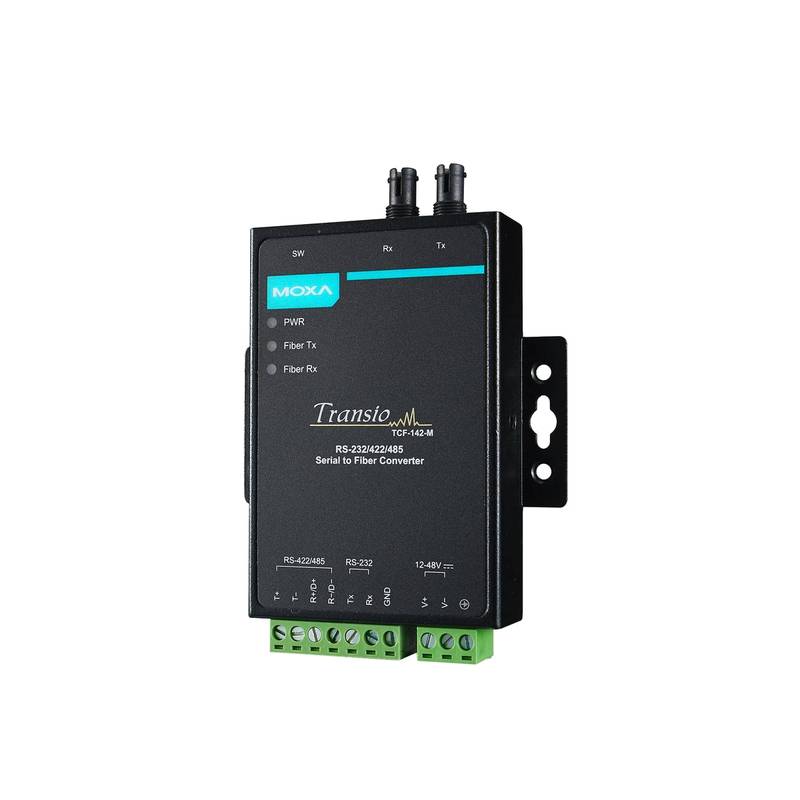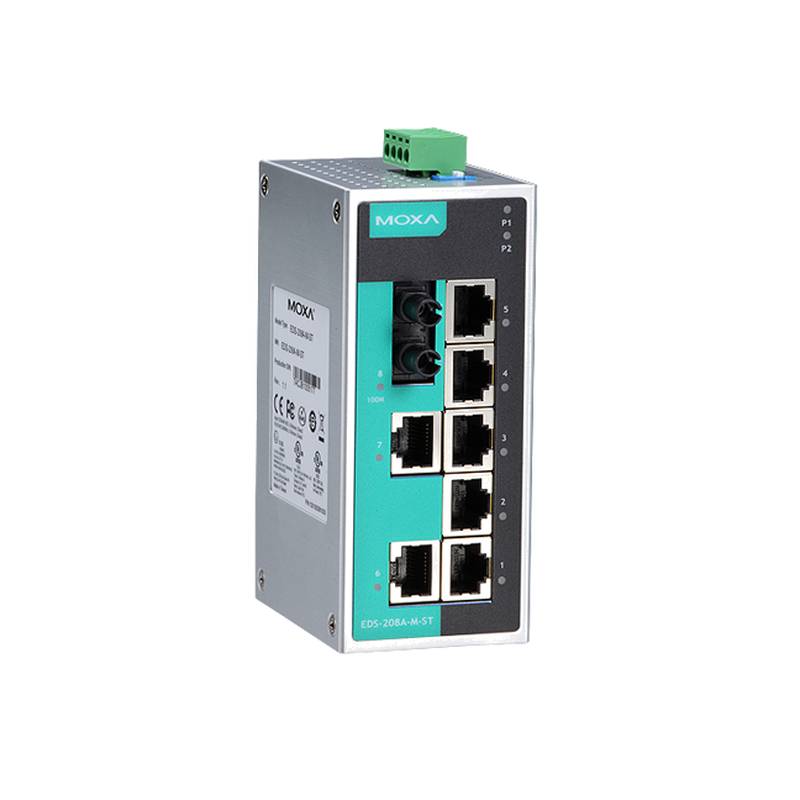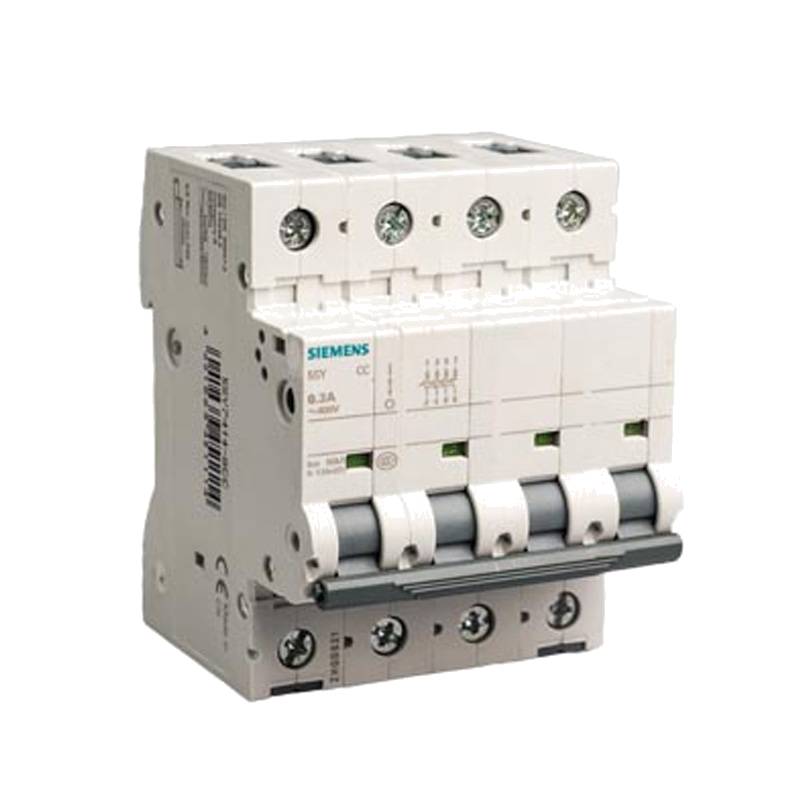
The Moxa TCF-142-S-SC is a robust industrial media converter designed to bridge the gap between electrical and optical Ethernet networks, offering a reliable solution for extending network distances and enhancing signal integrity in demanding environments. This device stands out with its support for single-mode fiber, enabling transmission over extended distances up to 30 km, a critical advantage for large-scale industrial deployments. Its compact design, DIN-rail mountability, and wide operating temperature range (-40 to 75°C) make it exceptionally well-suited for factory floors, substations, and outdoor applications. The SC interface ensures straightforward and secure fiber optic connectivity. Key technical parameters include its dual fiber optic connectors, automatic MDI/MDI-X for twisted-pair ports, and surge protection on the electrical interface, all contributing to its industrial-grade performance and reliability.
Product Specifications
| Feature | Specification |
| :-------------------- | :---------------------------------------------- |
| Fiber Port Type | SC Connector |
| Fiber Type | Single-mode |
| Max. Transmission Distance | 30 km |
| Ethernet Ports | 1 x 10/100BaseT(X) (RJ45) |
| Fiber Wavelength | 1310 nm |
| Power Input | 12/24/48 VDC (9.6-60 VDC) |
| Operating Temperature | -40 to 75°C |
| Mounting | DIN-rail, Wall-mount |
| Dimensions | 31 x 112 x 73 mm |
| Warranty | 5 years |
Core Features & Market Positioning
The Moxa TCF-142-S-SC distinguishes itself through its industrial-grade construction and unwavering reliability, crucial for sectors where network downtime is simply not an option. Its single-mode fiber capability is a significant differentiator, allowing for superior long-distance data transmission compared to multi-mode fiber, making it ideal for sprawling industrial sites or geographically dispersed operations. The inclusion of an SC interface is a widely adopted standard, ensuring compatibility with a vast array of existing fiber optic infrastructure. Furthermore, Moxa's reputation for producing ruggedized networking equipment places the TCF-142-S-SC in a strong market position for applications demanding high availability and performance in harsh conditions. The converter's built-in surge protection on the copper port adds another layer of resilience against electrical disturbances, a common concern in industrial settings.
Key Application Scenarios
This media converter is particularly valuable in scenarios requiring robust, long-range communication. In manufacturing automation, it facilitates the extension of control networks between distant production lines or from the plant floor to a central control room. For intelligent transportation systems (ITS), the TCF-142-S-SC enables the reliable transmission of data from traffic management devices or surveillance cameras over significant distances, often across urban or rural landscapes. In the power and utilities sector, its ability to operate reliably in harsh environments makes it suitable for extending network connectivity to remote substations or monitoring equipment. The single-mode fiber support is also critical for backbone network extensions in large campuses or city-wide deployments where distances exceed the limitations of multi-mode fiber.
Practical System Integration Guidance
Integrating the Moxa TCF-142-S-SC into an existing network is a straightforward process. Installation typically involves mounting the converter onto a standard DIN-rail within an industrial enclosure. For the copper Ethernet port, a standard twisted-pair cable (Cat5e or higher recommended) connects to your network switch or device. The single-mode fiber optic cable, terminated with SC connectors, should be connected to the corresponding SC port on the TCF-142-S-SC and to the remote fiber optic device or switch. Ensure proper fiber optic cable management to avoid bends that could degrade signal quality. Power is supplied via a terminal block, supporting a wide DC input range, which allows for flexibility in power source selection. Polarity of the DC power input should be observed during connection.
Operation and Risk Mitigation
The TCF-142-S-SC is designed for plug-and-play operation, requiring no complex configuration for basic functionality. Its robust design includes LED indicators for power, fiber link status, and Ethernet activity, aiding in quick diagnostics. To mitigate operational risks, ensure that the power supply voltage is within the specified range to prevent damage. Use appropriate fiber optic cleaning tools to maintain the cleanliness of the SC connectors and fiber end-faces, as contamination is a primary cause of signal loss. In environments with significant electrical noise or surges, verify that the unit is properly grounded and consider additional surge suppression measures for the power supply if extreme conditions are present. Regular inspection of fiber optic cable integrity is also recommended.
Scalability & Long-Term Value
The Moxa TCF-142-S-SC offers significant long-term value due to its inherent scalability and compatibility with evolving industrial networking standards. By leveraging single-mode fiber, it provides a future-proof solution capable of supporting higher bandwidth demands as they arise, simply by upgrading the transceivers at either end of the fiber link, should newer technologies become available. Its industrial-grade build quality ensures a long operational lifespan, minimizing replacement costs and reducing the total cost of ownership. The converter seamlessly integrates with existing Ethernet infrastructure, allowing for phased network upgrades without the need for a complete overhaul. Its support for standard protocols ensures broad interoperability with various industrial devices and control systems, including those embracing Industrial Internet of Things (IIoT) initiatives.
Frequently Asked Questions
What is the maximum distance the Moxa TCF-142-S-SC can transmit data?
The Moxa TCF-142-S-SC is engineered for extended reach, capable of transmitting data over single-mode fiber optic cables for distances of up to 30 kilometers. This remarkable range is crucial for connecting geographically dispersed industrial assets or spanning large factory complexes. Careful selection of the fiber optic cable and ensuring minimal splices will help achieve this maximum specified distance reliably.
This significant transmission capability makes it an ideal choice for backbone connectivity in sprawling industrial campuses or telecommunication infrastructure. The single-mode fiber technology inherently supports longer distances compared to multi-mode fiber, offering a cost-effective solution for long-haul industrial networking requirements. It eliminates the need for intermediate repeaters, simplifying network design and reducing potential points of failure over such distances.
The 30 km range ensures that the converter can effectively bridge communication gaps in sectors like utilities, transportation, and large-scale manufacturing where equipment may be located far from control centers. Proper fiber optic cable quality and installation practices are essential to fully realize this extended reach.
How do I connect the Moxa TCF-142-S-SC to my network?
Connecting the TCF-142-S-SC involves simple steps for both the electrical and optical interfaces. For the 10/100BaseT(X) Ethernet port, use a standard Cat5e or higher twisted-pair Ethernet cable to connect to your network switch or end device. The single-mode fiber optic port, equipped with an SC connector, requires a single-mode fiber optic patch cord to link to your fiber optic network infrastructure.
Ensure that the power supply is connected to the terminal block, observing the correct polarity for DC input. The wide voltage range (9.6-60 VDC) offers flexibility in power source selection, common in industrial settings. Once powered and connected, the device typically operates in a plug-and-play manner, automatically negotiating speed and duplex settings on the Ethernet port.
Verify connectivity by checking the status LEDs on the front panel. These LEDs provide visual confirmation of power, fiber link, and Ethernet activity. Regular cleaning of the SC fiber connectors and the fiber end-face is crucial to maintain optimal signal quality and prevent connection issues.
What are the primary benefits of using a Moxa TCF-142-S-SC in an industrial environment?
The TCF-142-S-SC offers robust industrial-grade construction, designed to withstand harsh environmental conditions such as extreme temperatures (-40 to 75°C) and electrical interference. Its single-mode fiber capability extends network reach significantly, crucial for large facilities or remote deployments. The SC interface ensures compatibility with widespread fiber optic infrastructure.
Its inherent reliability minimizes downtime, a critical factor in industrial operations where disruptions can be costly. The converter also provides electrical surge protection on the copper port, safeguarding connected equipment from power fluctuations and transient voltages. This hardened design translates to a longer operational lifespan and reduced maintenance requirements.
This media converter acts as a crucial bridge between different network media, allowing for the integration of legacy copper-based devices into modern fiber optic networks or extending network reach beyond the limitations of copper cabling. Its compact size and DIN-rail mounting facilitate easy integration into control cabinets.

























